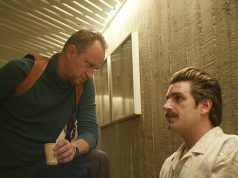Movies like “Lagaan” make me glad I’m a film critic. If I were a civilian, I probably wouldn’t see a four-hour Indian film set in 1893 and centered around the game of cricket. I would believe all the critics who told me it was a great film, but I would assume it was of those films you admire more than you enjoy, and if I’m going to spend four hours on something, I’d better be ENTERTAINED, darn it.
But as a film critic, I had to watch it whether I wanted to or not, and I’m glad I did. It’s the sort of high-spirited foreign film that Americans dig because it doesn’t seem all that foreign. The storylines are familiar, and so are the characters. All the most pleasant cliches of a Hollywood sports film — when you need a homerun to win the game, you pretty much always get a homerun — are here, translated into cricket terms and enacted by Indians.
Oh, and there are musical numbers.
Yes! Musical numbers. Indian films are famous (notorious?) for allowing their characters to burst into song at random junctures. It would be hard to call “Lagaan” a “musical” — it has only six songs in 224 minutes; most musicals have twice as many in half the time — but sure enough, there are the song-and-dance bits, with catchy music and literally translated lyrics in the subtitles. (“The snake of tiredness should not bite you” is one of my favorites.) I don’t know whether these exuberant numbers are supposed to be funny, but to a Westerner who is amused when people burst into song in non-musical films, they are highly entertaining in a “Like-a-Virgin”-in-“Moulin-Rouge” kind of way.
When someone makes a four-hour film, you almost have to take notice of it, because someone has clearly gone to a lot of effort. There is no truly defensible reason for director Ashutosh Gowariker to have made “Lagaan” as long as it is, but the effect of all that time spent watching it is a marvelous one, like a lengthy, scenic car trip to a place you love visiting.
The story is of a village in India where all residents must pay a tax, or “lagaan,” to the controlling British government. A local lad named Bhuvan (Aamir Khan) runs afoul of the snively, cruel, racist Capt. Russell (Paul Blackthorne), who proposes a mean-spirited wager: a cricket match, British officers vs. villagers. If the villagers win, they don’t have to pay lagaan for three years. If the Brits win, the Indians must pay triple lagaan this year.
Bear in mind, the Indians have never played cricket before and barely know the rules. But Bhuvan has no choice but to accept the wager. The villagers have already been told to pay double lagaan this year, and doing so would wipe them out. Either they play cricket — and win — or they will starve.
This gives the film more weight than your average sports movie. What’s at stake here is not a trophy, or self-respect, or the love of a woman. It’s survival.
It’s enjoyable, and oddly comforting, to see elements of American films appear in this one. A rag-tag group of non-athletes join forces to beat the odds. The bad guy’s sister, Elizabeth (Rachel Shelley), thinks her brother is cruel and helps the villagers. A guy jealous of the hero for stealing his girlfriend seeks his defeat and turns traitor. Elizabeth learns the native language extraordinarily fast. Bhuvan has a romance, and a romantic triangle (involving a local girl played by Gracy Singh, who is as compelling as many cute Hollywood actresses). There’s even a musical montage during the Indian team’s training in which they chase chickens, “Rocky”-style, to learn agility.
If this were a Hollywood production, we would criticize it for being unoriginal. But somehow, transporting all these familiar conventions to a different time and place makes them fresh again.
There is a certain amount of religious faith involved, too. The villagers are suffering from a drought — that’s why they can’t afford to pay double lagaan — and they wonder why God is punishing them. But maybe what God’s doing is testing, not punishing.
Bhuvan is a good, heroic leading man — too heroic, maybe, as he seems to be utterly without fault (though Khan plays him with a healthy dose of Ordinary Guy normalcy). The supporting characters are quirky, too, from the Rasputin-looking town prophet to the temple worker who screams when he does pretty much anything.
Technically, all of the musical number could be cut. There’s 35 minutes right there. And while the cricket team needs 11 players, I don’t think each member needs to have a scene explaining why he agreed to sign up. And does the three-day cricket match need to occupy a solid hour of the film? No. Even if I knew how to play cricket, I doubt I’d be riveted by as much of it as appears here.
But cutting any of this would hinder the film’s impact. As it stands, we feel a sense of epicness, a sense of truly having lived in these interesting people’s lives for a few hours. The details are often entertaining, but more importantly, they are threads in a very satisfying tapestry, if I may be the 1,000,000th person to use that analogy. “Lagaan” can be enjoyed on several levels, not the least of which is the one where you just sit back and enjoy a skillfully made, good-natured movie.
B+ (3 hrs., 44 min.; in Hindi and Bhojpuri with English subtitles; )





